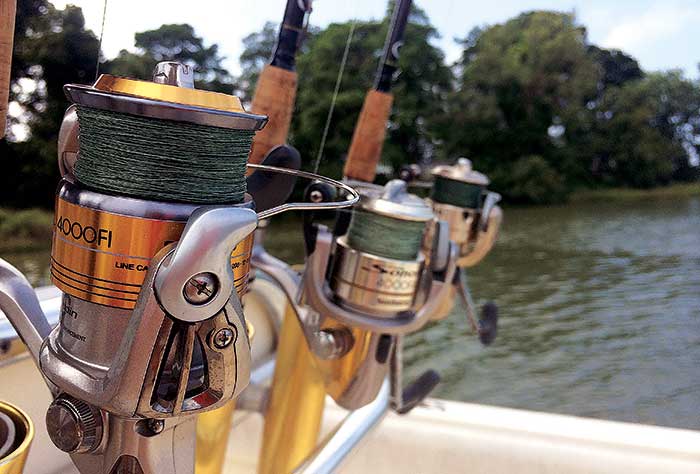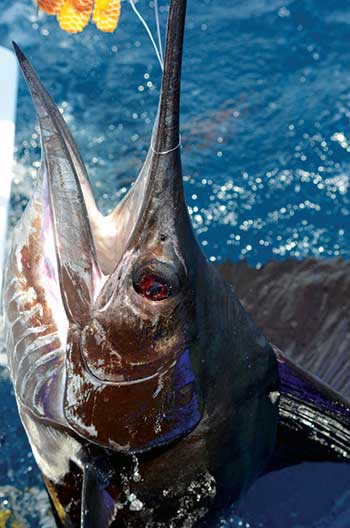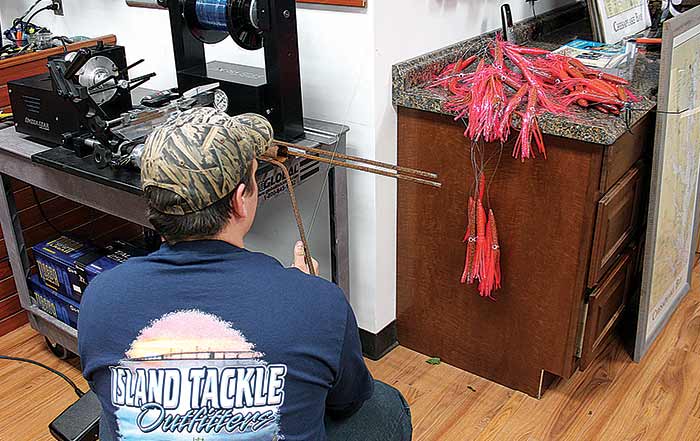Advertisement
The only thing between you and the fish is your line. Here's how to choose the right one.

A reel spooled up with braid plus a fluorocarbon monofilament leader lets you tackle a powerful species such as tuna, because you need low visibility and stretch in the line. (Photo: Stephanie Vatalaro)
There are a mind-boggling number of fishing lines to choose from, and each has its own strengths and weaknesses. Do you know when to choose monofilament over braid? When to use fluorocarbon? What type of leader you need in different fishing situations? Understanding the different characteristics of these fishing lines — and which to choose, when, and why — will help you become a better angler.
Braid Versus Monofilament

A heavy-duty leader like this one will resist the chafe from the
rough bill of a sailfish. (Photo: Michael Vatalaro)
When it comes to modern fishing lines, the braid-versus-mono debate is probably the biggest source of disagreement among anglers. First, let's get square with what each of these materials has to offer. Monofilament has been around for the better part of a century (it was first marketed as a fishing line by DuPont more than 75 years ago), consists of a single strand of nylon, and is made via an extrusion process. On the plus side, it's relatively inexpensive, knots easily, and has quite a bit of stretch. But mono is degraded by sunlight and only good for a season or two, offers relatively low sensitivity, and maintains memory when put on a spool — that's why you sometimes have to fight those springy coils of line spilling off your reel. And that aforementioned stretch can be a disadvantage in certain fishing situations.
If you use the term "braid" loosely, you could apply it to the cotton lines used long before the advent of monofilament. But to today's angler, braid usually refers to lines made of multiple filaments of gel-spun polyethylene that are braided together. This stuff became popular in the early 1990s and is made in two varieties: Spectra (made by Honeywell) and Dyneema (made by DSM, based in the Netherlands). The difference between them? Not much. Inside the industry, they're known as "sister lines" because they're so similar and share the same basic advantages: they're shockingly strong for their diameter (40 percent to 50 percent stronger than monofilament, in many cases), have greatly enhanced sensitivity, have no memory, and don't stretch at all. They also have one glaring weakness: braids cost twice as much as monofilaments. Aside from this, braid's disadvantages mirror their advantages. That incredible sensitivity that allows you to feel a fish's gentle nibble also allows the fish to feel you on the other end of the line. And that absence of stretch may make for a firmer hook set, but it can also cause hooks to rip free from the fish's mouth or, if your drag isn't properly set, even result in a broken rod.
Things are about to get really, really simple here, folks. Because when these monofilament and braid traits are considered together, they allow us to make a generalization that's true the vast majority of the time: when you're fishing with bait, use (high-stretch, low-sensitivity) monofilament, and when you're fishing with lures, use (low-stretch, high-sensitivity) braid. Fish will almost always hold bait in their mouths for some amount of time either before they run or you feel them and set the hook, so in this case, monofilament's low sensitivity and high stretch offer serious advantages. But when fish strike a lure, it's almost always just that — a strike — and you need to make sure tension is applied ASAP to set the hook. Hence, braid's zero stretch and high sensitivity give you a leg up.
Tip
Fieldwork backs up this generalization. During the mid-1990s, I spent two full seasons pitting monofilament against braid, side by side. When I was chumming or drift fishing with bait, monofilament won, on average, by a 3-to-1 margin. When I was vertical jigging with plastics or spoons, trolling a wide range of lures, or casting and retrieving, braid won by about the same margin.
There are, however, a few exceptions of which you should be aware. First off, surface plugs work better with monofilament because the zero-stretch aspect of braid causes the plug to hop out of the water during the retrieve and become tangled. And when you're fishing for large, powerful species with lures, a 20- to 25-foot monofilament shock leader is necessary to prevent pulled hooks and broken rods when a fish surges near the boat. Finally, when fishing in extremely deep water of 500 feet or more, braid is a must because mono stretches so much that you won't even be able to feel your weight hit bottom or know when you have a fish on the line.
Rough It Up
Wait! What about resistance to abrasion? Some experienced anglers say monofilament is in order when you're fishing around lots of snags because braid poorly resists abrasion. Other fishermen say just the opposite, but no one seems to know the truth. To answer this question, I went to Island Tackle Outfitters, a tackle shop in Chester, Maryland, that keeps hundreds of different lines and leaders in stock. The company gave me access to all those lines, as well as the scales needed to test breaking strength.
To simulate real-world abrasion, my testing team brought an old grappling anchor made from welded rebar — exactly the kind of snag your line might rub up against while fishing. After selecting assorted brands of braid and monofilament in 20-, 30-, 50-, and 80-pound tests, we stroked the fishing lines eight inches up and down across the rebar anchor arms, with five pounds of downward pressure. The 20- and 30-pound tests received two strokes, while we gave 50- and 80-pound tests six strokes against the rusty metal. After we applied the abrasion, each line was pulled against a Manley factory-calibrated scale until breaking; we did this to measure how many pounds of test each line retained after being roughed up. We repeated the test three times for every line sample, then averaged the results.

Stroking the lines against rusty rebar arms provided plenty of abrasion for our test. (Photo: Lenny Rudow)
With 20-pound test, the results were slightly in favor of monofilament. It retained an average strength of 19 pounds; the braid retained an average strength of 17.4 pounds. When we went to 30-pound test, however, the results were far more significant: 28.2 pounds for monofilament to 17.4 pounds for braid. And when we doubled the abrasion to six strokes and moved up to 50-pound test, the mono retained 50 pounds of strength while the braid was cut through on the sixth stroke. With 80-pound test, the braid retained a mere 2 pounds of strength while the mono again tested at its rated strength.
But how could the 50- and 80-pound-test mono lines not be weakened by the abrasion? They were, but they broke at the stated rating because virtually all line manufacturers intentionally underrate breaking strengths to make it seem as if the line performs better than the claim. In reality, most lines stamped as 50-pound test actually have a breaking strength of 60 to 70 pounds.
Manufacturer ratings aside, our test proved two things without a doubt: monofilament line is better at resisting abrasion, and although the advantage starts small with low-diameter lines, it grows epically as line size increases. If you're fishing in an area with lots of sharp snags, you'll definitely want to make sure you use monofilament line, or certainly at least a mono leader.
Advertisement
End Of The Line
Leaders, of course, are in their own category. Virtually everyone agrees that braid's no-stretch characteristic disqualifies it for use as a leader because without some stretch on the initial strike, the hook often rips free. But what type of monofilament is best for this job? Fluorocarbon tops the list for use in leaders. Compared with other types of monofilament, fluorocarbon bends light much as water does — which means it's the type of monofilament that's least visible to fish.
The refractive index for a material indicates the amount that light bends as it passes through that material; the refractive index for water is 1.33. If fishing line could be made with this exact refractive index, it would blend in perfectly and be unnoticeable. But the closest regular monofilament comes is around 1.62. Fluorocarbon, however, has a refractive index of 1.42 — making it considerably less visible underwater than other monos. So when you're fishing in clear water and pursuing a species of fish with high visual acuity, you can't afford to use anything other than a fluorocarbon leader. Unless, that is, you can't afford fluorocarbon — 50-pound test commonly costs more than $1 per yard.Regular monofilament leader, on the other hand, costs 12 to 15 cents per yard.
In dingy, muddy, or stained waters, save your cash and go for monofilament because in such water, fish can't see well anyway. The same goes when you're fishing for species that don't depend mainly on sight, like catfish or carp. But when you're fishing for a species with keen eyesight, like tuna, or you're fishing in gin-clear waters, the extra investment is worthwhile.
Tip
Multicolor Madness
We've yet to discuss color, but not by mistake. I saved this topic for last, because in my experience — and to my surprise — it's one of the least important factors to consider. I've tried fishing red lines next to green lines, clear lines next to fluorescent lines, and so on, ad nauseam. Amazingly, the results show little to no difference. True, high-vis lines are advantageous when you're using a technique that requires you to keep track of the line's position, like kite fishing. Yes, lines color-coded for length can come in handy when trolling or dropping to suspended fish at a specific depth. But the fish just don't seem to give a hoot what color line you offer.
A final note about lines: whatever type you pick, it should always be wound onto the spool by a professional, with the right amount of tension. Otherwise, the line can become pinched and tangled before it ever makes it off the spool. The folks at Island Tackle Outfitters recommend making sure that the tackle shop you choose for the job has a hydraulic tensioner, which ensures the line gets packed on with even pressure throughout the spool. And whatever offering you might choose to tempt those fish into biting, remember this: picking out the best line for the job is an important part of turning those bites into a successful day of fishing.
